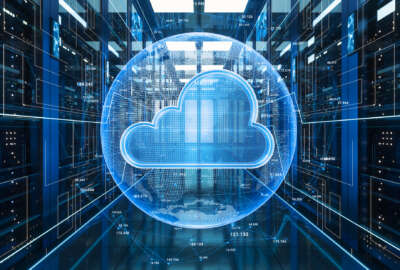Major General plays major role in Army’s IT hardware and software synergy
Army platforms depend on software, and software has to run on the often old or limited hardware mounted aboard ground vehicles.
Army platforms depend on software, and software has to run on the often old or limited hardware mounted aboard ground vehicles. At this week’s Association of the U.S. Army (AUSA) conference, the Federal Drive with Tom Temin discussed what’s going on with the commander of the Army’s Communications and Electronics Command, Maj. Gen. Robert L. Edmonson II.
Interview Transcript:
Robert Edmonson II I’m a part of a team of 9,000 IT professionals distribute around the globe. And we are responsible for all of the sustainment, which is the sustainment operation of all of your command control, communications, computers, information, surveillance reconnaissance equipment.
Tom Temin So you do software and hardware?
Robert Edmonson II We do both hardware and software. Absolutely right.
Tom Temin All right. And would you say sustainment? Let’s define that term.
Robert Edmonson II Right. That’s a great question. So when I think of sustainment, I think of an Army operation. And so when I think of sustainment, I think of the different classes of supply. And much like weapons systems, much like ammunition. I literally, with the team, we consider both the hardware and the software components of all C5, ISR, how they need to be replenished, how they need to be repaired, and how they need to be sustained over the long haul. We work anywhere from the defense industrial base all the way into the foxhole.
Tom Temin Got it. In that C5 ISR that used to be C2, then it was C3, then a C4. Now it’s C5.
Robert Edmonson II And one day it’s probably going to be something else, because this is an example of how the army is continuing to evolve. And frankly, SEACOM, in response to how the Army is delivering the army of 2030, designing the Army of 2040, SEACOM, that’s a part of AMC, will continue to evolve over time. And as you’ve already noted, our acronym has changed over the years. At this point in time, the synergy between hardware and software is probably no greater than any point in my entire Army career than it is today.
Tom Temin And to a much greater extent, it’s fair to say that a lot of the SEACOM software is embedded in the platforms, which creates a different type of integration challenge than the days when it was pretty much signal based. All of this work.
Robert Edmonson II Absolutely. And now when you look at all the different systems that we have, those systems are not designed to operate independently anymore. Those systems are designed to operate in an integrated fashion, not just interoperable, but to operate in an integrated fashion, which means that we need to be able to, as in the United States Army and specifically SEACOM over the long haul, synchronize the level of hardware with the level of software so that at the tip of the spear, at the point of need for the soldiers, the system works the way that it needs to work when called upon.
Tom Temin Yeah, a lot of publicity, a lot of talk has been about this replication program that the Defense Department announced, but they are talking mostly about aerial unmanned types of vehicles. But the Army has a ongoing program and I think development of unmanned ground systems, which you don’t hear as much about, but those have to operate in concert, the swarm idea, if you will. That’s a part of your software development thinking, also?
Robert Edmonson II When we think about the entire network, the entire network includes soldiers. It includes unmanned capabilities. And so to your point, when we need to integrate all of those systems, it is the Army Materiel Command, the SEACOM Enterprise, that has the right level of experts distributed around the globe. And that’s extremely important that they are distributed around the globe, embedded with maneuver formations. At times they are full time distributed around the globe, living on the ground, and they’re the ones that are able to operate at a higher level. So if a soldier ever has a challenge, and this is extremely important, if a soldier ever has a challenge with any of the hardware software, they know exactly where to reach. And that’s reaching in to the AMC enterprise and reaching into Communications Electronics Command and reaching directly to some of the 9,000 experts that I had previously mentioned.
Tom Temin But as an operational concept, I mean, the Army is thinking about interoperability of manned and unmanned ground vehicles such that an operation could have drone things on wheels or walking or whatever they might do. We all communicate as a unit.
Robert Edmonson II Yes, absolutely. The integration between manned and unmanned is absolutely something that the Army is working hard on. It’s something that we completely understand. Why not leverage an unmanned capability to perform an action that can be performed by an unmanned platform? And that leaves the tasks that soldiers must perform to the soldiers, the living, breathing Americans that are the ones that we are here to support. They were the ones that we asked to put their lives in harm’s way at times. So we are absolutely aimed at decreasing their risk using unmanned where appropriate. And then again, leaving those ethical, moral decisions as an example to the humans.
Tom Temin Right. Autonomy will never extend to shooting, for example, so far as we can plan right now.
Robert Edmonson II Right. That’s a human decision.
Tom Temin And that gets to the question of artificial intelligence and machine learning. That must be coming big time into SEACOM.
Robert Edmonson II It absolutely is. And we are searching there’s a race for talent that’s happening today. And so we have very smart hardware engineers. We have very smart software engineers. We have educated our hardware and our software. And I’m going to come back to software and focus a little bit more on them. We are educating our software experts in agile ways of delivering software capabilities. We are enhancing our lab capabilities so that we can roll out software at a faster rate. We are synchronizing that rollout of hardware at a faster rate with the software that we are also are responsible for sustaining as an operation. And then when we start to talk a little bit more about AI and ML, that’s where we are very excited, We’re very interested, we’re reaching out to industry, we’re reaching to the local colleges and universities. We’re taking a very close look at our duty descriptions and quite frankly determining who is it that we need to hire. What type of person do we need to bring into our organization that can continue to perform sustainment operations of hardware, software, AI and ML?
Tom Temin And talking about the workforce, you mentioned 9,000 people. How many are uniformed, how many are Army civilians, and what about contractor support? How does that all break?
Robert Edmonson II So of that 9,000, 92% of the 9,000 are civilians. And of the 92%, we have got about a 50-50 mix between contractors and Department of the Army civilians. And so the soldiers that we have in the organization are more senior in nature. They’re the ones that we will have been most recently in the field. We will bring them into the organization. We will leverage their talent so that we can continue to be forward looking. And then we also can take good, constructive criticism from the soldiers when they come into our organization. They give us advice as to how we can do business even better. And so, again, that allows us to operate in a more into in fashion.
Tom Temin So in other words, you don’t have uniforms coding in Python necessarily. That’s civilian people.
Robert Edmonson II In our organization, we do not have soldiers coding in Python. I can’t speak for Army Futures Command. I’ll let them speak for themselves, but our soldiers today are not coding hands on keyboard.
Tom Temin And I was wondering about your connection or relationship with something like say, Missile Command, which is very software intensive ground systems and networking and all of this. How do you interact with them? Do you have any part of what they do?
Robert Edmonson II We absolutely do. We have a close partnership with all of the product managers, with all of the product managers, the PEOs. And we coordinate. We have formal lines of communication and informal lines of communication. So the systems that you’re referencing, we have a direct responsibility and ensuring their sustainability over time. So we’re involved early in the acquisition cycle, we’re involved early in the acquisition cycle from the perspective of our ability to sustain that equipment over time. And when I say sustain the equipment, I literally mean our ability to perform sustainment operations at the speed of war.
Tom Temin Because the hardware has a long lifecycle, and it has to be ruggedized and so forth, for the most part for Army platforms. And so I imagine a lot of the future software sustainment has to be. Have to ensure that it occurs in a way that can still be supported by hardware that might have been around a while.
Robert Edmonson II You’re absolutely right. There is a dependency between hardware and software that cannot be lost, and that’s part of our end to end way that we perform sustainment operations inside SEACOM. The end to end again takes us from the very beginning of the development all the way to how the system, the hardware and software functions for the soldier on the battlefield. And to your point, the synchronization of the hardware and the software is what we do inside Communications Electronics Command, along with our partners that are in the PEO, in the PM community. But the synchronization is critical. We cannot put ourselves in the position of having hardware that is not able to run the software. Conversely, we cannot allow software to outpace the hardware and that’s where we’re responsible. Again, that 9,000 person workforce that I described a little bit earlier, they do a tremendous job of synchronizing Army hardware with Army software for the soldiers.
Tom Temin Yeah, you don’t throw out the software every couple of years and get a new iPhone, so to speak. That is stuff that has to be around a while.
Robert Edmonson II And the risk tolerance associated the difference between an iPhone and a combat platform, we cannot assume that kind of risk at all.
Tom Temin And what about the feedback loop say of the field back to SEACOM. Someone might have a new package that’s to update the operation of a tank. I’m just making this up. Well you know what? We told it to turn one degree and it turned 1.1 degree. You have to reprogram something. Do you have that feedback mechanism?
Robert Edmonson II We absolutely do. We receive the feedback two different ways. One is will receive the feedback from the PM’s, and they’ll sometimes ask us to make modifications to hardware or modifications to software in response to feedback from the soldiers. But we also, as a part of that 9,000 person workforce, we have Department of the Army civilians and contractors that work for us on the ground with the soldiers receiving that direct feedback, and they bring it directly into communications electronics command, and so that the information flow is not only from the PM to SEACOM, but is from SEACOM back to the PM.
Tom Temin What’s the E2E pipeline?
Robert Edmonson II The end to end pipeline has everything to do with our ability to be able to think not only at the headquarters and above level or at the lab and above level, but is our ability to take ownership of the hardware and the software all the way into the foxhole. And to be responsible for the systems that we are sustaining, the systems that we are upgrading along the way to ensure that they are functional for the soldiers to soldiers understand how to operate those systems. And so as an example, before we will issue a new piece of software, we’ve got a responsibility to write the technical manual that describes to the soldier, the user, what the new process is and what the new benefits are. And when you’re thinking end to end, that means you’re not stopping at the lab level alone. You’re not stopping at the Ph.D. level where we’re putting hands on keyboard, developing new types of software. But you’re actually thinking about how you’re going to implement all the way into the foxhole for the soldier. And to have that ownership really does get back to your earlier question about how do you receive feedback. You’re going to receive a lot of feedback when you really take ownership of your software in an end to end fashion.
Tom Temin And if there’s a bug or a glitch, you’ll hear about it pretty quick.
Robert Edmonson II Absolutely. Absolutely, we will.
Copyright © 2024 Federal News Network. All rights reserved. This website is not intended for users located within the European Economic Area.
Tom Temin is host of the Federal Drive and has been providing insight on federal technology and management issues for more than 30 years.
Follow @tteminWFED






